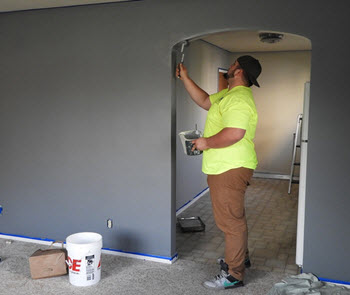In finance, equity is the difference between the valuation of an asset and the liabilities attached to it. If the valuation is higher than the liabilities, the equity is positive. If the liabilities are larger than the value, the equity is negative.
 When you apply for a home equity loan, you offer the lender the equity (or part of the equity) in your home as collateral for the loan. If your application is approved and you go ahead and borrow the money, the equity will be reduced because a lien will be created against the home.
When you apply for a home equity loan, you offer the lender the equity (or part of the equity) in your home as collateral for the loan. If your application is approved and you go ahead and borrow the money, the equity will be reduced because a lien will be created against the home.
If you want to buy a home and take out a mortgage loan to pay for it, this is normally not referred to as a home equity loan, even though, if we want to be literal, it is. Instead, the term home equity loan is typically used when you already have a mortgage loan with your home as collateral but have some available equity and use that equity as collateral for a second loan. Because of this, the terms home equity loan and second mortgage (loan) are often used interchangeably.
In general, the first mortgage loan (“bottom loan”) on a home will be longer term and have a lower interest rate than any other mortgage loan taken out while the initial mortgage loan still exist. This is because the first mortgage loan (“bottom loan”) is prioritized over the second mortgage loan if the borrower defaults and the home is sold through foreclosure. The lender with the bottom loan will be repaid first, and the other lender(s) will only be paid if there is any money from the sale left over after that.
Since a home equity loan is secured debt, you can typically negotiate better terms and conditions for this loan compared to unsecured debt (e.g. credit cards and personal loans).
A home equity loan can be a great way of financing projects that will actually increase the market value of your home, such as renovations and add-ons. However, most lenders will not require that you use the money to finance home improvements. Home equity loans are used to finance a wide range of things, from traveling around the world to paying medical bills.
Examples of fees that you may have to pay in order to be approved for a home equity loan:
HELOC = Home Equity Line of Credit

A HELOC can be used to improve your house and increase your equity.
A HELOC is a line of credit where the home is used as collateral.
With a traditional home equity loan, you apply for a specific sum and if your loan application is approved the lender deposits that sum into your account. You then gradually pay back that sum in accordance with a fixed repayment plan.
A HELOC works differently. With a HELOC, you are approved for a specific credit amount, but you don’t have to use all of it. You can for instance be approved for a credit of $50,000 but elect to just take out $2,000 to pay for an emergency dentist visit.
Example:
As you can see, Isabella’s available credit will fluctuate up and down depending on how much of the credit space she has already used up. She has a revolving line of credit.
If you have used your HELOC in a responsible way for some time, you might get a notice from the lender, offering to increase your available line of credit. Due to your responsible use of your available credit, your creditworthiness in the eyes of the lender has increased and they are willing to let you borrow more than before.
Positive home equity = the market value of the home exceeds the liabilities (debts).
Here area a few things you can do to increase home equity:
This article was last updated on: February 27, 2018